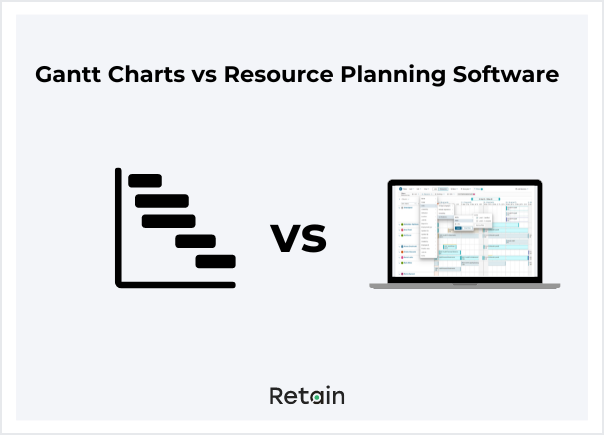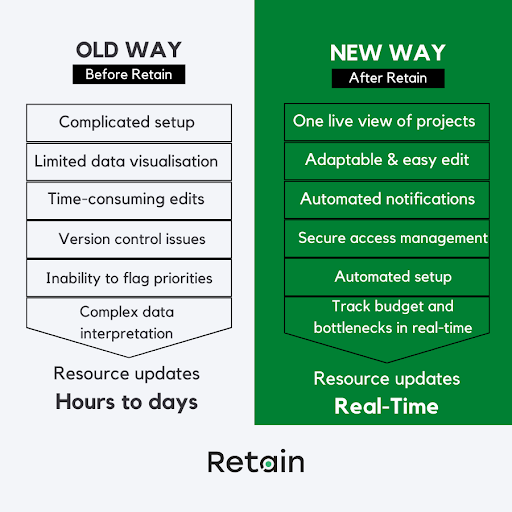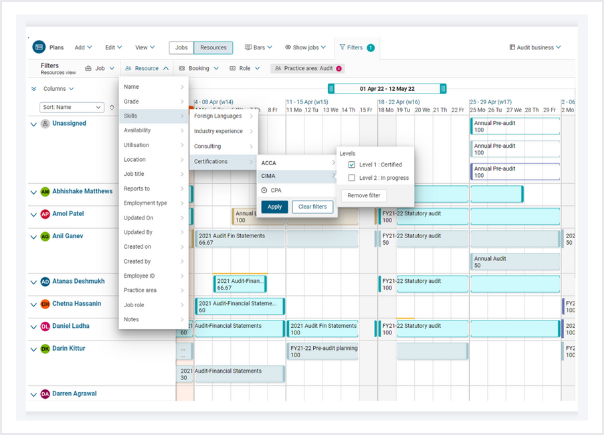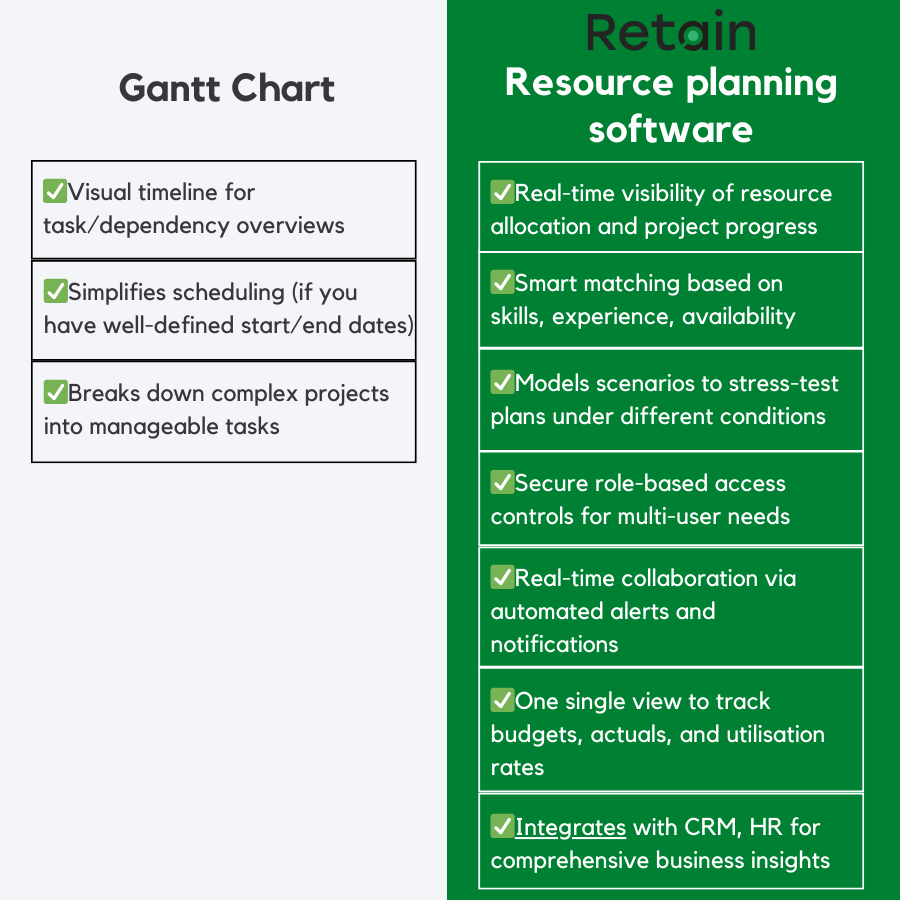In this blog, we'll compare old and new resource planning approaches using Gantt Charts. We'll look at the benefits of specialist resource planning software and provide practical guidance on choosing the right tool for your team.

For decades, resource planning data has typically been confined to manual calculations and basic Gantt Charts. Combine this with new work methods, last-minute changes, and access limitations—and it's understandable why many project managers find it difficult to keep everything on track.
The problem? Traditional Gantt Charts remain stuck in siloed spreadsheet formats. While useful for providing visual timelines, their manual nature often causes more issues than solutions. Complicated setup, restricted data visualisation options, and the inability to securely share information with stakeholders make efficient project management an uphill task.
So, what’s the solution? The latest resource planning technology is reinventing Gantt Charts, offering significant enhancements that go way beyond simple data visualisation.
Resource planning Gantt Charts: The old vs. new way
Gantt Charts have long allowed businesses to visualise project timelines. But, times have changed. This traditional way of managing resources doesn’t meet today’s resource planning needs.
Here’s what we mean by this:

Let’s break this down a bit more…
The old way:
🔸 Complicated setup: Creating resource planning Gantt Charts in tools like Excel take serious effort. From inputting task lists to mapping resource requirements, the process is clunky at best and less than ideal for complex projects.
🔸 Limited data visualisation: Gantt Charts are great at providing a high-level overview of resources and timelines but if you want to see more specific detail quickly, it simply can’t.
🔸 Time-consuming to edit: Need to adjust task dates or resource allocation quickly? Expect to spend time manually recalculating. Even the smallest changes take effort and can open the doors to errors and inconsistencies.
🔸 Version control issues: Static spreadsheets aren’t made for sharing. When you need multiple team updates, it creates version control nightmares. On top of this, sharing resource planning Gantt Charts—and the data underpinning it—limits access control. Role-based permissions aren’t possible.
🔸 Inability to highlight priorities: There’s no simple way to flag and communicate priorities across teams, forcing project managers to guess critical tasks.
🔸 Complex data interpretation required: Now, we know there is a major data specialist shortage and not all businesses can afford them. So, without this expertise, key insights can be overlooked.
🔸 Inflexible: Its static nature means businesses are often unable to capture and adapt to fast-moving project changes easily.
Enter: resource planning software.
The new way:
🔹 One live view of projects: With resource planning software—like Retain—you simply need to log in to access one shared view of the schedule. No clunky set up. It takes seconds to log in.
🔹 Easy edit: User-friendly interfaces make it accessible for all skill levels. Plus, you can customise views to match team skills, preferences and project needs.
🔹 Adaptable: In just a few clicks, you can drag and drop to quickly assign resources and adjust timelines.
🔹 Automated notifications: To keep everyone aligned when changes occur, reducing the issues linked to a breakdown in communication.
🔹 Secure access management: With read/edit/view permissions by role, customised access controls allow for greater data security.
🔹 Automated setup: Automating routine tasks like milestones, phases, and even link dependencies.
🔹 Visibility into job progression: Track jobs as they progress so you can spot critical decision points.
🔹 Real-time bottleneck identification: Quickly spot bottlenecks and proactively stop projects from falling behind schedule.
🔹 Track client budgets and prevent overruns: Integrated budget and billable hour tracking to control costs and prevent overruns.
To sum up: This form of a modern Gantt Chart for resource planning leverages modern software to provide powerful visualisation, automation, and control capabilities that simply aren't possible with traditional spreadsheet-based methods.
Keen to learn more? In the next section, we'll look at how specialist resource planning software streamlines your resource management processes.
Gantt Chart alternative for resource planning: Benefits of specialist software
Advanced resource planning software tools—like Retain—make it incredibly easy to assign the best people to projects quickly and efficiently. The right tech empowers resource managers to seamlessly allocate resources based on comprehensive insights into skills, availability, and certifications—all at the click of a button.
Resource planning Gantt Charts with Retain
Unlike generic visualisation tools, Retain's Gantt Chart is designed specifically for resource managers' needs. Intuitive drag-and-drop scheduling streamlines editing tasks, and dependencies, and makes adjustments. Plus, automated alerts keep teams informed on critical project changes to reduce communication gaps.

Customisable dashboards allow toggling between perspectives for managing resources across projects or filtering by specific teams. And you can easily switch views to cater to the unique requirements of different resource planning approaches.
And it’s not just Gantt Charts that it ticks off. There’s so much more…
Wider benefits of resource planning software:
Here's a quick look at some of the additional resource management benefits Retain provides:
🔹 AI-powered planning: Rapidly locate unassigned resources, filter by specific skills, and view availability at a glance.
🔹 Intelligent resource matching: Assign people to projects based on nuanced skills, certifications, experience, and capacity.
🔹 Time tracking and billable hours: Log time against projects and calculate billable hours to control costs.
🔹 Scenario modelling: Stress-test plans by modelling ‘what-if’ scenarios to assess the impact of changes.
🔹 Real-time utilisation visibility: Compare forecasted vs. actual utilisation to quickly identify gaps and make adjustments.
🔹 Centralised planning with access controls: Optimise schedules with calendar views and secure, role-based access.
🔹 Hit expected ROI and goals: Link projects to strategic goals and quantify the expected business impact.
🔹 Unified budget and resource tracking: Monitor project budgets, actuals, and resource time allocations in one system.
Now, this all sounds quite theoretical. So, let’s now look at how it works in practice.
How to manage resources with resource planning software Gantt Charts
You already know that efficiently managing resources is pivotal to any project's success. But by combining a well-structured Gantt Chart with the right software, you can optimise workflows and ensure the most suitable team members are assigned to each task—ensuring people aren’t under or overutilsed.
Here’s a step-by-step approach:
1. Define resource requirements:
🟢List all project tasks and break them into phases
🟢Identify required resources (people, skills, equipment, materials) for each task
🟢In Retain, you can even add resources to your management system, categorising by skills, certifications, experience
2. Assess availability before scheduling:
🟢Use Gantt views to see resource availability across all active projects
🟢Ensure balanced workloads by comparing individual schedules
🟢Retain’s smart resource matching helps you quickly identify the best fit for each role based on specific skills and experience, not just availability
3. Estimate hours for better capacity planning:
🟢Add time estimates for each task to the resource planning Gantt Chart
🟢With Retain, you can break estimates down by assigned resource to balance workload and prevent burnout
🟢You can track time directly in Retain or easily integrate your chosen time-tracking software.
4. Schedule resources to projects:
🟢Drag-and-drop resources to assign them directly in the Gantt view
🟢Adjust timelines and dependencies with smart controls
🟢Set automated milestones, phases, and linked dependencies
🟢Ensure all key decision points are captured and that tasks are completed on time
5. Monitor and optimise resource utilisation:
🟢Track actual vs estimated hours to identify gaps
🟢Track actual hours logged against estimated hours to identify gaps and make corrections
🟢In Retain, you can view real-time utilisation rates to see where adjustments are needed
6. Model scenarios to stress-test plans:
🟢Run what-if scenarios to see how changes in timelines, resource availability, and budgets impact your overall resource plan
🟢Adjust schedules and resources based on scenario outcomes
7. Securely keep everyone in the loop:
🟢With Retain you can keep sensitive data safe with the ability to manage read/edit/view permissions for secure multi-user access
🟢Automate notifications notify team members of changes, ensuring everyone is on the same page
By leveraging specialist resource planning software's robust Gantt Chart and resource management capabilities, you can effectively allocate the right resources to every project.
Sounds good so far? Up next, we'll provide a checklist to guide your decision between Gantt Charts and resource planning tools.
Gantt Charts vs resource planning software: How to choose
If you’re still on the fence in the Gantt Chart vs resource planning software debate, let’s look at how to choose. We’ll start with a simple comparison. We’ve covered a lot of these points previously but we find it helps to compare things side-by-side:
Pros

Cons

So now, the question is: What’s right for your business? Here’s a quick checklist.
Checklist for choosing:
Gantt Charts may suffice if:
🟢You only need a basic visual timeline of tasks
🟢You prefer working with static spreadsheets over dynamic software
🟢You're managing a single, defined-scope project
🟢Minimal team collaboration is required
🟢Your team is small and in the same location
Consider resource planning software if:
🟢You juggle resources across multiple concurrent projects
🟢You need in-depth resource insights like skills, certifications, availability
🟢You want to model different scenarios to stress-test plans
🟢Real-time visibility and collaboration across teams is crucial
🟢You require robust access controls and data security
🟢You have a medium to large, distributed or remote team
Read more about what’s inside a specialist resource management tool here ➡️
To sum up: Choosing the right tool depends on your team's unique needs. If you're looking for a Gantt Chart alternative for resource planning, specialist software–like Retain–provides tailored features that simplify scheduling and optimise resources.
We’ve covered quite a bit of ground so let’s wrap up with the key points.
Use the best Gantt Chart alternative for resource planning
Resource planning has outgrown manual spreadsheets and basic Gantt charts. Today's projects require real-time visibility, intelligent resource matching, and comprehensive scenario modelling capabilities that traditional Gantt charts simply cannot provide.
Specialist resource planning software like Retain offers a powerful Gantt Chart alternative, empowering resource managers to:
🟢Plan with confidence: Leverage AI-powered matching and in-depth insights into skills, certifications, and availability to seamlessly schedule the right people for every task.
🟢Stay aligned: Automated alerts, notifications, and secure role-based access controls keep all team members and stakeholders informed and data protected.
🟢Control time & budget: Monitor project budgets, actuals, and utilisation rates within a unified system to ensure initiatives stay on track and within scope.
🟢Stress-test scenarios: Model different what-if scenarios to assess how changes in timelines, availability, and budgets impact overall resource planning.
🟢Maximise efficiency: Identify and address bottlenecks and utilisation issues proactively with real-time forecasting and monitoring capabilities.
If you're seeking a Gantt Chart alternative that elevates resource planning, Retain provides tailored features to help you spend less time fixing off-target plans and more freeing time up for other value-adding tasks.
Don't just take our word for it–here's what our clients say:
Huron
“Retain allowed us to automate reports that were previously tracked manually. This not only made our team more efficient but also provided a higher quality product since it minimised user error.” – Senior Resource Planner.
Read the full case study here.
Mazars
“At Mazars, we don’t have an anonymous pool of people, it’s important to us that we match the right person to the right project. We found Retain to be the solution that best met our requirements.” – Aedin Morkan, Audit & Assurance Director.
Read the full case study here.
Pitcher Partners
“It’s user-friendly, very flexible, and customisable to your own liking.” – Selmi van Staden, Director of Audit Ops.
Read the full case study here.
Ready to save time and money on resource planning? Book a demo with Retain today and experience a smarter way to manage your projects.
Worried it’s not worth the investment? Crunch the numbers in this ROI calculator.


